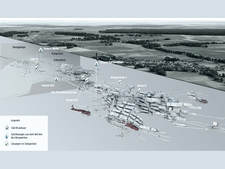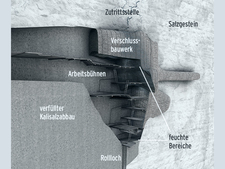Influent solutions and brines

![]() Overview about influent solutions and brines (in German only)
Overview about influent solutions and brines (in German only)
In practically all mines, various volumes of influent solutions and brines occur. This is also the case at different points in the Morsleben repository for radioactive waste. Influent solutions are groundwater that is saturated with rock salt and flows into the mine workings from outside. Solutions originate from the operation of the mine or were enclosed when the salt rock was generating. In contrast to the solutions from the operation of the mine, the latter are also entirely saturated with rock salt.
All the influent solutions and brines are collected, part of them is used inside the mine, e.g. to construct roadways. Furthermore, the influent volumes, the temperature, the density (to determine the salt content) and the chemical composition are continuously determined to recognise possible changes at an early stage.
Influent solutions

![]() Chart of the sealing structure in "Lager H" (in German only)
Chart of the sealing structure in "Lager H" (in German only)
In 1907, an inflow of water was detected for the first time in a former potash mine working to the north of the Marie shaft, the so-called "Lager H". Based on examinations it is assumed that the water stems from the overburden. 40 m below the top of the salt dome it flows into "Lager H" via a small potash seam (rock layer with potash). From there it is led via a cribbed chute into the area of the 1st level and pumped out regularly.
It was possible to considerably reduce the initially strong inflow of eight litres per minute, which had temporarily flown into the mine (cf. Figure). The influent volume currently amounts to ca. 13 cubic metres per year, which corresponds to about 1.5 litres per hour. To observe and control the inflow, the access to the sealing structure is kept open.
Brines from the operation of the mine
The largest volumes of influent brines in the Morsleben repository have been caused by former and present mining operations.
The by far largest volume flows into the mine via the two shafts, since they penetrate aquifers of the overburden. Each year, about 11,000 cubic metres are collected in the shafts via so-called shaft water drainages consisting of drip-mouldings (similar to a gutter) and collecting tanks and pumped to the surface, if necessary. The salt content of the brines flowing into the mine via the shafts is relatively low. Therefore, they can be pumped into the river Aller on the basis of existing permits under Water Law.
Furthermore, humidity gets into the mine via the ventilation of the mine (supply of fresh air). Water from the humid mine air condenses and concentrates in so-called brine pools. About 15 cubic metres of these brines are annually pumped out of the pools and used for roadway construction. Furthermore, several thousand cubic metres of water have gathered in the Marie mine on the 500-m level (near blind shaft 500), due to a defective mine dewaterer during post-war operation and due to the cleaning waters of former underground chicken farming. With the exception of relatively small residual volumes, they were used to produce salt concrete in the context of stabilisation measures carried out in the central part.
Furthermore, spill-over solutions have formed during concrete setting in the framework of the stabilisation measures. To control the spill-over solution, a precautionary approach has been developed and implemented parallel to the advancing backfilling operation. An essential component of this precautionary approach was the collection of the spill-over solutions, their collection in containers and pumping the solutions to the surface. The pumped-off solutions were then again used to produce salt concrete. From 2003 until 2011, altogether, 2,445 cubic metres of spill-over solutions have been collected and used to produce salt concrete in the framework of the stabilisation measures. Spill-over solutions are also collected after completion of the stabilisation measures. Until the end of 2013, their total volume had increased to 2,499 cubic metres. Ca. 0.3 cubic metres are collected per week (status: as of June 2014).
Brines in salt rock
Inside the salt structure there are blocks of anhydrite (rock frequently generating as a result of sea water evaporation). According to the present state of knowledge, they have no contact to the groundwater in the overburden. Mining activities may cause these brines to flow into the cavities. At present, such brines are found and collected at two points.
In an old exploration drilling in the Marie mine, 2 litres per year are collected on average.
In 2013, ca. 10 cubic metres were collected in mining district 1a in the upper part of the mine. Compared with previous years, the volume has increased. This is considered to be due to geo-mechanical and thermal changes in the scope of the stabilisation measures carried out in the central part. The additional weight and the heat that was brought into the mine openings along with the salt concrete, cause modified tensions and enhanced convergence rates in the central part. Through this, existing flow paths have slightly changed. It is expected that the volume of influent brines will decrease when the brought in salt concrete cools down.
Another inflow point in gallery 5 is not accessible at present. In the past, however, the inflowing volumes were very small with about 2 litres per year. At a former point of inflow in the so-called "Bunte First" in the Marie mine no inflows can be observed currently.
State of 2016.06.10

